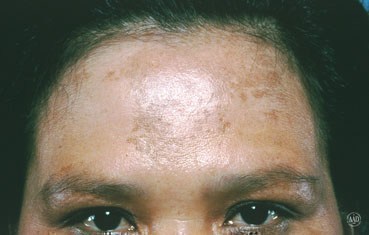What is Melasma?
Skin on the face can become hyperpigmented, a condition in which brown spots make your complexion blotchy. The brown results when your pigment-making cells (melanocytes) produce more melanin. There are two common causes of this.
- Solar lentigoes, more commonly known as age spots or liver spots. These result from sun damage, and are common in both men and women. They appear in sun-exposed areas such as the face, arms and hands. They are more common after middle age, after years of cumulative sun damage.
- Melasma, also known as the mask of pregnancy. This type of hyperpigmentation often develops during pregnancy, or when starting birth control pills, and is mostly seen in women. It more often takes the form of patches of dark skin, rather than discrete spots (see image below). Melasma is common over the forehead and cheeks, but may also be seen on other parts of the body such as the arms.
 There are several ways to treat both types of hyperpigmentation:
There are several ways to treat both types of hyperpigmentation:
- Sun avoidance. Sunlight stimulights your melanocytes to make more pigment, so avoiding sun exposure is critical. Try to stay out of the sun during the peak hours of 10am-2pm. Wear long sleeved shirts or hats for additional protection. Be sure to reapply sunscreen every two hours.,
- Topical medications such as hydroquinone and RetinA.
- Laser treatments. One type of laser treatment (BBL, or IPL) that works very well for sun-induced pigmentation can actually make melasma worse, so it is important to tell your doctor if you think you have melasma. In this case, a profractional laser treatment may be more effective.
If you are considering treatment for sun spots or melasma, let your doctor know if any of your dark spots are new or changing; it is important to rule out skin cancer prior to administering any treatments that lighten the skin.
